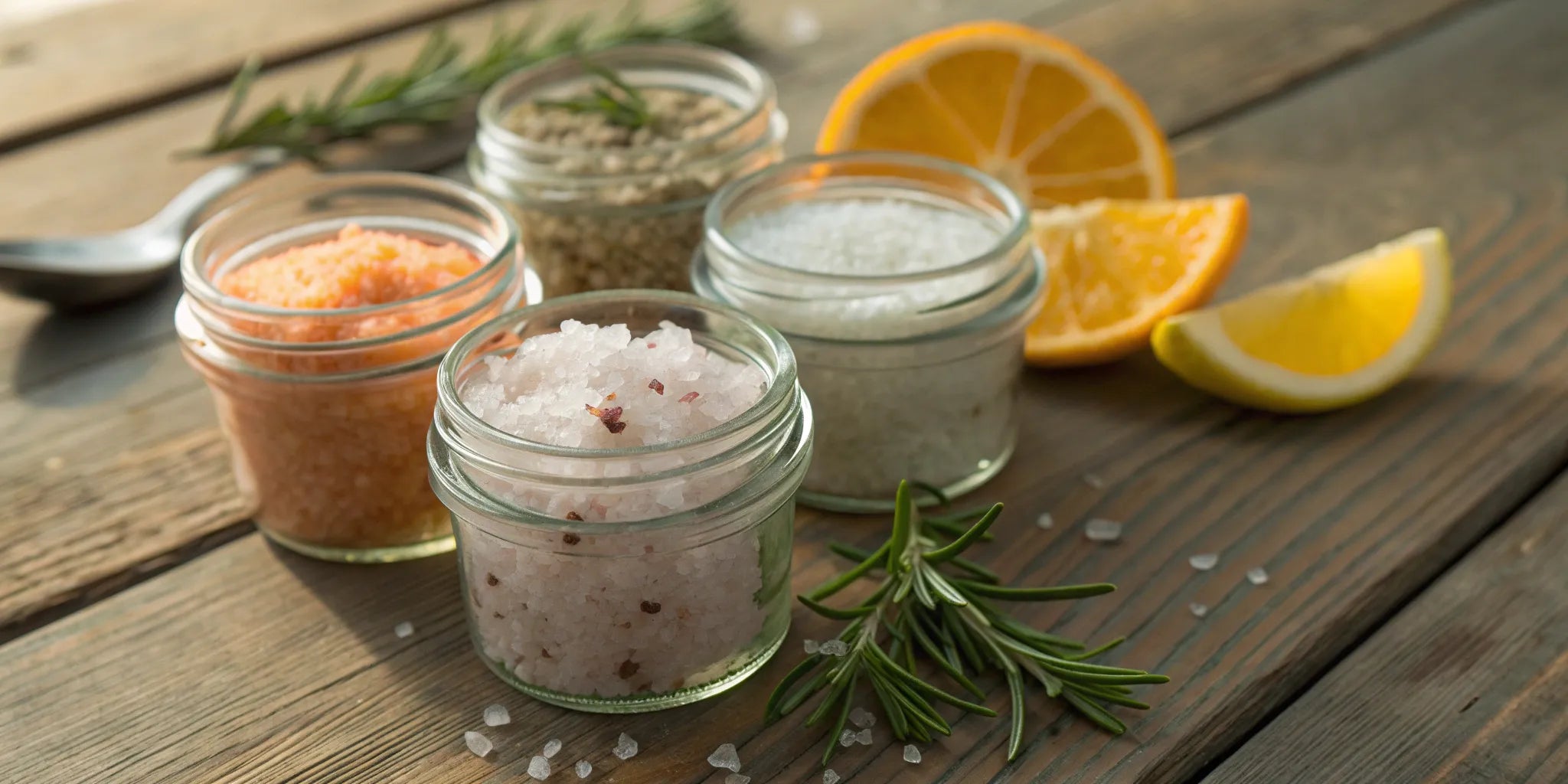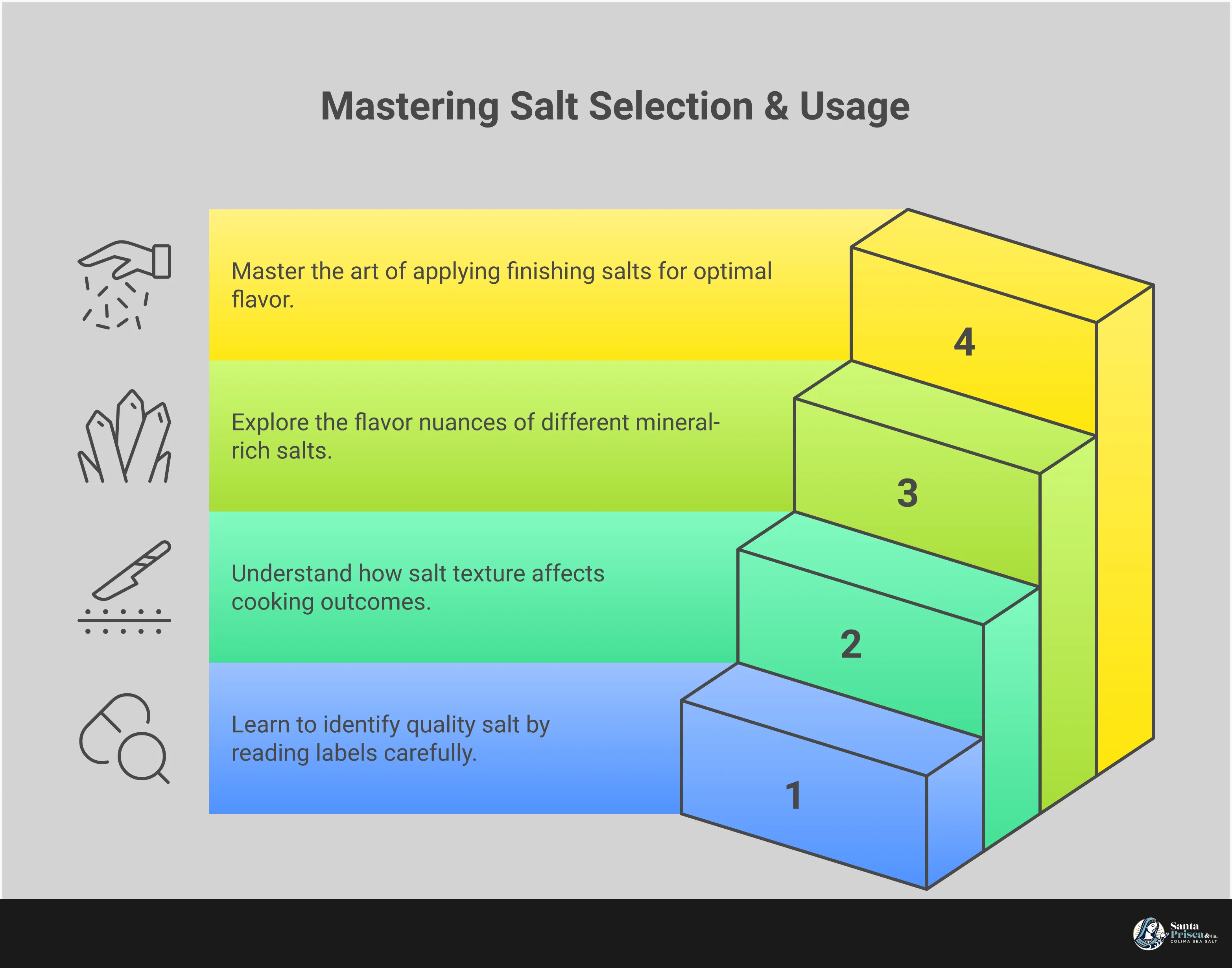5 Essential Non-Iodized Salt Brands to Know
Written By Santa Prisca & Co Staff Last updated on
Salt is so much more than just salty. A truly great salt has character, texture, and a subtle complexity that can bring a dish into beautiful balance. Think of the harsh, one-note flavor of processed salt versus the clean, mineral depth of a hand-harvested sea salt flake dissolving on your tongue. The difference is transformative. Learning to distinguish between them is a culinary journey in itself, much like learning about olive oils or spices. This guide will walk you through the nuances of artisanal salts, helping you explore different non iodized salt brands and understand how to use their unique textures and flavors to make your cooking more vibrant and thoughtful.
Key Takeaways
- Choose Purity for a Cleaner Taste: Opt for unrefined, non-iodized salts to avoid additives and experience the clean, complex flavor that comes from naturally occurring trace minerals.
- Season with Intention: Match the salt's texture to its purpose—use a reliable kosher salt for seasoning during cooking and a delicate, flaky sea salt as a finishing touch for a final burst of flavor and crunch.
- Read the Label to Find Quality: A truly great salt has a simple ingredient list: just salt. Look for words like "unrefined" and "hand-harvested" to ensure you're choosing a product that is pure and thoughtfully sourced.
What Makes Non-Iodized Salt Different?
When you reach for the salt shaker, what are you really adding to your food? For many of us, it’s a simple, uniform white grain—iodized table salt. But there’s a whole world of salt beyond that, one that’s deeply connected to the earth and offers a more nuanced experience for your palate. Non-iodized salts, like pure sea salt, invite us to season our food with intention, connecting us to the natural elements that created them.
Choosing a non-iodized salt isn’t just about what’s left out; it’s about what remains. These salts carry the essence of their origin, whether it’s a sun-drenched salt flat or an ancient mountain range. This choice allows you to appreciate an ingredient in its most authentic form, free from additives and full of character. It’s a small shift in the kitchen that can make a meaningful difference in how you cook and taste.
Discover Its Natural Mineral Profile
Unlike highly processed table salt, which is stripped of its natural components, unrefined non-iodized salts retain a beautiful spectrum of trace minerals. These elements, like magnesium, potassium, and calcium, are naturally present from the water and earth where the salt was formed. This is what gives artisanal salts their unique color, texture, and subtle complexity of flavor.
Our own Colima Sea Salt, for example, is hand-harvested from a lagoon fed by an ancient volcano. This process ensures the salt keeps its rich mineral profile, resulting in a crisp, clean flake with a burst of mineral depth that you just don’t find in a standard shaker. It’s a taste of place, a direct connection to the land.
How It Differs from Iodized Salt
The primary distinction is simple: iodized salt is fortified with iodine, an essential nutrient. This practice began decades ago as a public health initiative to combat iodine deficiency. While effective, the process often involves refining the salt to pure sodium chloride, removing its natural minerals, and then adding iodine and anti-caking agents.
Non-iodized salt, on the other hand, is left in its natural state. It contains the minerals it was born with and is free from additives. While most modern diets provide sufficient iodine from other sources like fish, dairy, and eggs, choosing a non-iodized salt allows you to control your ingredients and enjoy a purer, more flavorful product.
A Mindful Approach to Salt and Health
Ultimately, the choice between iodized and non-iodized salt comes down to personal preference and culinary intention. Are you looking for pure salinity, or do you want a salt that adds its own unique character to a dish? Using a hand-harvested sea salt is an invitation to slow down and appreciate the story behind your ingredients.
Being mindful of your body’s needs is always important. If you have concerns about your iodine intake, it’s a good idea to speak with a healthcare professional. For most home cooks, however, using a high-quality, unrefined sea salt is a beautiful way to bring natural flavor and a sense of ritual to your kitchen, turning the simple act of seasoning into a moment of connection.
A Curated Guide to Non-Iodized Salts
Navigating the world of salt can feel surprisingly complex, but choosing the right one is a simple act of intention that can transform your cooking. Non-iodized salts are celebrated for their pure flavor and rich mineral content, free from the additives found in common table salt. They offer a direct connection to the earth, each crystal telling the story of its origin. From the sun-drenched flats of Mexico to the ancient salt beds deep underground, these salts are more than just a seasoning—they are an ingredient in their own right. This guide will help you explore a few essential types and understand how to use them to bring depth, texture, and a touch of tradition to your kitchen.
Santa Prisca & Co. Colima Sea Salt: Rooted in Tradition
Our Colima Sea Salt is a beautiful expression of place and patience. Hand-harvested from a volcanic lagoon in Colima, Mexico, these unrefined crystals are born from a tradition that honors the rhythm of nature. The salt is naturally filtered through the volcanic earth, which gives it a clean, complex flavor and a wealth of trace minerals. Unlike processed salts, its taste is bright and pure, without any harshness. Its versatile, crisp flake is beloved by chefs for everything from seasoning grilled meats to brightening fresh vegetables. Each pinch is a reminder of the sun, the water, and the hands that gathered it, bringing a sense of gratitude to the simple act of cooking.
Exploring Other Artisanal Sea Salts
Once you begin to appreciate the nuances of unrefined salt, a whole world opens up. Artisanal sea salts are defined by their unique terroir—the specific environment where they are harvested. You might encounter the delicate, pyramid-shaped flakes of Maldon salt from England, perfect for a crunchy finish, or the mineral-heavy, moist grey salt (sel gris) from the coasts of France, which adds a briny depth to stews and roasted foods. Learning about the different types of salt is a culinary journey in itself. Each one offers a distinct texture and flavor profile, inviting you to experiment and discover how they interact with your food.
The Role of Traditional Kosher Salt
Think of kosher salt as the dependable workhorse of the kitchen. This non-iodized salt is a favorite among chefs for good reason. Its coarse, irregular crystals are easy to pinch and distribute evenly, making it ideal for seasoning meat before cooking, seasoning pasta water, or using in brines and cures. Because it contains no iodine, it delivers a pure, clean saltiness that won’t interfere with the other flavors in your dish. While it may not have the delicate complexity of a finishing salt, its consistency and reliability make it an essential tool for building flavor from the very first step of a recipe.
Add a Final Touch with Finishing Salts
A finishing salt is the final flourish, the thoughtful detail that elevates a dish from good to memorable. These are the salts you sprinkle on just before serving. Their purpose is to add a burst of clean flavor and a delightful, crunchy texture that contrasts with the food. A beautiful, flaky sea salt like ours is perfect for this. Imagine the gentle crunch on a sliced avocado, the shimmer of crystals over a chocolate torte, or the pop of salinity on a perfectly ripe tomato. Using a finishing salt is a small ritual that draws attention to the care you’ve put into your meal, making it a true sensory experience. You can find authentic salt online to begin this practice.
How to Choose the Right Non-Iodized Salt
Choosing a salt is like choosing a foundational tool for your kitchen. The right one doesn’t just add salinity; it enhances flavor, creates texture, and brings a dish into beautiful balance. With so many options available, from fine grains to flaky crystals, it helps to think about how you’ll be using it. A salt that’s perfect for seasoning a steak on the grill might not be the one you reach for when baking a delicate cake.
Thinking about the salt’s purpose helps you select one with intention. Are you seasoning from the start, or adding a final flourish? Are you preserving summer vegetables or simply sprinkling over a fresh salad? Each application calls for a slightly different texture and mineral profile. Let’s explore how to match the right non-iodized salt to every moment in your kitchen, ensuring every meal is thoughtfully seasoned.

Your Go-To for Everyday Cooking
For daily use, you want a salt that is reliable, clean, and versatile. This is the salt you’ll keep in a cellar by the stove, ready for a pinch to season sauces, soups, and sautéed vegetables. When you’re at the store, look for products clearly marked as non-iodized or plain salt. Reading the label is a simple act of mindfulness that connects you to your ingredients. Understanding the difference between iodized and non-iodized salt is the first step in making a conscious choice for your pantry and your wellbeing.
The Best Salt for Baking and Preserving
Baking and preserving are culinary arts that rely on precision. Here, the texture and purity of your salt are paramount. Many kosher salts are excellent for these tasks because their clean flavor and consistent crystal size dissolve evenly without additives that can cloud a pickling brine or affect the delicate chemistry of baked goods. The right salt ensures your sourdough has a perfectly developed crust and your preserved lemons maintain their bright, vibrant flavor through the seasons. It’s a quiet but essential partner in your kitchen projects.
Perfecting Your Grill and Roast
When you’re working with open flame or high heat, a coarse-grained salt is your best friend. The larger crystals of a good kosher or sea salt are easy to pinch and distribute evenly over a roast or a thick-cut steak. They adhere well to the surface, creating a savory crust that seals in moisture and flavor. There’s something deeply satisfying about the feel of those crystals between your fingertips and the way they visibly season the food, promising a perfectly savory outcome before it even hits the heat.
Creating a Memorable Finishing Touch
A finishing salt is where you can truly play with texture and flavor. Sprinkled over a dish just before serving, these salts add a final, artful touch. The delicate, crisp flakes of a hand-harvested sea salt can bring a burst of mineral depth to a simple salad or a perfectly ripe tomato. Gourmet salts like our own Colima Sea Salt offer a clean, bright salinity that lingers on the tongue, transforming a simple meal into a memorable experience. This final layer of seasoning is an invitation to slow down and savor every bite.
How to Spot a Quality Non-Iodized Salt
Navigating the salt aisle can feel surprisingly complex. With so many options, how do you choose a salt that truly nourishes your body and enhances your cooking? The key is to look beyond the price tag and learn to read the story each salt tells through its label, texture, and origin. Choosing a quality non-iodized salt is an act of intention—a small but meaningful way to connect with your food on a deeper level.
When you know what to look for, you can confidently select a salt that is pure, mineral-rich, and free from the unnecessary additives found in common table salt. It’s about understanding that salt isn’t just a seasoning; it’s a fundamental element that carries the essence of its environment. From the sun-drenched flats of Colima to your kitchen table, a great salt brings with it a story of place and process. Let’s explore the simple markers of quality that will help you make a mindful choice every time.
Read Labels and Certifications with Confidence
Think of the salt label as its honest introduction. The most important first step is to look for the words “non-iodized” or “unrefined sea salt.” Many brands produce both iodized and non-iodized versions, so checking carefully is key. A quality salt will have a very short ingredient list—ideally, just one ingredient: salt. This transparency is a sign of a brand that trusts in the purity of its product. While salt itself cannot be certified organic, you might see other certifications that speak to the company’s ethical or environmental practices. Reading the label is your first step in choosing ingredients that align with your wellness values.
What the Mineral Content Tells You
A truly natural, unrefined sea salt is more than just sodium chloride. It’s a beautiful mosaic of trace minerals that reflect its unique origin. Our Colima Sea Salt, for example, is filtered through volcanic earth, which imparts a whisper of magnesium, calcium, and potassium. These minerals don’t just contribute to a more complex, nuanced flavor; they also give the salt its distinct character and texture. When you see a salt that isn’t stark white, but rather has a subtle, natural hue, you’re likely looking at a salt that has retained its rich mineral profile. It’s a beautiful reminder that our food comes from the earth, carrying its elemental gifts.
Why the Process Matters
How a salt is gathered and prepared is just as important as where it comes from. Many commercial salts are heavily processed, stripped of their natural minerals, and heated to extreme temperatures. In contrast, artisanal salts are often hand-harvested using traditional methods passed down through generations. This gentle approach preserves the salt’s delicate crystal structure and its full spectrum of minerals. When you choose a hand-harvested salt, you are not only getting a superior product but also supporting sustainable practices and the communities that depend on them. It’s a way of honoring the immense care and human touch involved in bringing this essential ingredient to your kitchen.
Common Additives to Avoid
Flipping over a container of conventional table salt can be revealing. You’ll often find a list of ingredients that includes more than just salt. Common additions include anti-caking agents like sodium aluminosilicate or magnesium carbonate, which are used to ensure a smooth pour. Some iodized salts even contain dextrose, a form of sugar, to stabilize the iodine. Choosing a salt free from these food additives is a simple way to embrace clean eating and honor your body with pure, unadulterated ingredients. A quality salt doesn’t need anything extra to be exceptional—its natural form is already perfect.
How to Shop for Salt with Intention
Choosing a salt can be a simple errand or a beautiful moment of connection. When you approach the process with intention, you begin to see this humble mineral not just as a seasoning, but as a story. It’s an opportunity to ask where your food comes from, how it was made, and what it brings to your table beyond flavor. A truly exceptional salt carries the essence of its origin—the sun, the sea, and the hands that gathered it.
Shopping with intention means looking for quality, purity, and a process you can feel good about. It’s about choosing an ingredient that will not only season your meals but also align with a more mindful way of nourishing yourself and your family. This simple shift can transform your cooking, turning an everyday act into a small, grounding ritual.
Where to Find the Best Natural Salts
Your journey to finding beautiful, unrefined salts can begin in the aisles of a specialty food store or at your local farmers' market, where you can often speak directly with sellers. However, some of the most incredible salts are found online, sourced directly from the artisans who harvest them. Exploring these small-batch producers allows you to discover unique salts with rich histories. When you shop for salts from dedicated purveyors, you’re not just buying a product; you’re supporting a tradition and bringing a piece of a place into your home.
Key Qualities to Look For
When you pick up a package of salt, let the label tell you its story. Look for words like “unrefined,” “hand-harvested,” and the specific place of origin, like the Cuyutlán Lagoon. These details often indicate a salt that is free from anti-caking agents and has been minimally processed, leaving its natural mineral complexity intact. It’s also important to check if the salt is non-iodized. While many brands offer both, choosing a non-iodized salt ensures you’re getting a pure, unadulterated product for your culinary creations.
How to Store Your Salt Properly
Once you’ve brought a beautiful, natural salt into your kitchen, it deserves to be cared for. Proper storage protects its delicate texture and mineral-rich flavor. Unrefined sea salts can draw moisture from the air, so it’s best to keep them in an airtight container in a cool, dry place away from the steam of the stove. A simple glass jar with a tight-fitting lid works perfectly, or you can transfer a small amount to a wooden salt cellar for daily use. This simple act of care honors the journey the salt has taken to reach your kitchen.
A Note on Salt and Balanced Nutrition
Choosing non-iodized salt is a wonderful way to bring pure, unrefined flavor into your cooking. It’s also worth remembering that iodized salt was introduced to combat iodine deficiency. Iodine is a crucial nutrient that supports thyroid function. If you primarily use non-iodized salt, you can easily ensure you’re getting enough iodine through a balanced diet. Foods like seaweed, fish, yogurt, and eggs are all excellent natural sources of iodine that can help you maintain a well-rounded approach to wellness while enjoying the pure taste of artisanal salt.
Tips for Cooking with Non-Iodized Salt
Bringing a high-quality, non-iodized salt into your kitchen is an invitation to cook with more intention. It’s a simple shift that connects you more deeply to your ingredients, allowing their true flavors to come forward. When you leave behind the additives and anti-caking agents found in common table salt, you’ll notice a cleaner, more vibrant taste in everything you make. These tips will help you get the most out of every pinch.
Season with Confidence
When you’re working with a pure, unrefined salt, you can trust its flavor. Unlike iodized salt, which can sometimes leave a faint chemical or bitter note, a natural sea salt like our Colima Sea Salt offers a clean, balanced salinity. This purity gives you the confidence to season your food without masking its natural character. Start with a little, taste, and then add more as needed. Learning to season by feel and taste, rather than by exact measurement, is one of the most intuitive skills you can develop in the kitchen.
How Temperature Affects Your Salt
Understanding how salt interacts with heat can transform your cooking. Adding salt to meat well before it hits a hot pan draws moisture to the surface, creating a drier exterior that allows for a beautiful, deep brown sear. When boiling vegetables or pasta, salting the water seasons the food from the inside out, embedding flavor deep within. A sprinkle of salt on hot, freshly fried foods adheres instantly and enhances their crispness. Each application uses salt’s properties in a different way to build layers of flavor throughout the cooking process.
Understand Texture and How It Dissolves
Not all salt crystals are created equal, and their shape and size play a huge role in the final dish. A fine-grain sea salt will dissolve quickly and evenly, making it perfect for baking or creating smooth sauces and dressings. A larger, flakier crystal, however, offers a completely different experience. The crisp, delicate structure of a finishing salt provides a burst of mineral depth and a satisfying crunch that lingers on the tongue. Consider how you want the salt to perform—does it need to disappear into the dish, or do you want it to provide a final, textural flourish?
Simple Ways to Enhance Flavor
Sometimes, the most profound flavors come from the simplest combinations. A quality non-iodized salt has the power to amplify the inherent sweetness and complexity of fresh ingredients. Try a small pinch on a slice of a ripe, juicy tomato or a wedge of sweet melon—the salt balances the sweetness and makes the fruit taste more like itself. Sprinkle it over a simple avocado toast or onto your morning eggs. This small ritual encourages you to slow down and appreciate how one foundational ingredient can bring food to life. Explore our full collection to find the perfect salt for your daily rituals.
Related Articles
- Sea Salt for Cooking: Types, Benefits, and How to Use It Like a Pro
- The Benefits of Mineral-Rich Low Sodium Sea Salt
- Minerals in Sea Salt: What You Need to Know
- Mineralized Sea Salt 101: A Complete Guide
Frequently Asked Questions
If I stop using iodized salt, do I need to worry about my iodine intake? This is a thoughtful question that shows you’re cooking with wellness in mind. For most people, a balanced diet provides plenty of iodine from other natural sources like fish, seaweed, and dairy products. The practice of iodizing salt began as a public health measure when these foods were less accessible. If you have specific health concerns, it’s always best to chat with a healthcare professional, but for most home cooks, choosing a pure, non-iodized salt is a beautiful way to focus on clean ingredients.
Why does my unrefined sea salt sometimes clump together? Seeing a little clumping in your salt cellar is actually a good sign. It means your salt is completely natural and free from the anti-caking agents, like sodium aluminosilicate, that are commonly added to processed table salt to make it pour perfectly. A natural sea salt will absorb a bit of moisture from the air, but a gentle tap is usually all it takes to loosen the crystals. It’s a small reminder that you’re using an ingredient in its pure, unadulterated state.
Can I use any non-iodized salt as a finishing salt? While you can technically sprinkle any salt on a finished dish, the best finishing salts are chosen for their texture. A hand-harvested flake salt, for example, provides a delicate, satisfying crunch and a bright burst of flavor that dissolves slowly on the tongue. A coarser kosher salt might feel too aggressive. The intention behind a finishing salt is to add a final layer of texture and sensory delight, so a beautiful, crisp flake is almost always the perfect choice.
Is there a noticeable taste difference between non-iodized sea salt and regular table salt? Absolutely. Once you start tasting them side-by-side, the difference is remarkable. Highly processed table salt often has a sharp, one-dimensional salinity, and some people can even detect a faint chemical note from the iodine or anti-caking agents. A natural, unrefined sea salt offers a cleaner, more complex flavor with a subtle mineral depth that enhances food without overpowering it. It makes your ingredients taste more like themselves.
What's the difference between kosher salt and a hand-harvested sea salt like Colima? Think of kosher salt as a dependable kitchen workhorse. Its coarse, uniform crystals are perfect for seasoning from the start, like salting pasta water or creating a crust on a roast, because it provides a clean, straightforward saltiness. A hand-harvested sea salt is more of an artisanal ingredient. It carries the unique mineral profile of its origin—its terroir—which gives it a more nuanced flavor and a delicate, flaky texture that makes it ideal for finishing a dish with a thoughtful touch.

